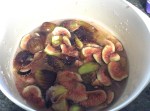
I don’t make this claim lightly, but this is the best version of a chocolate self-saucing pudding that I’ve ever tasted! The recipe comes from my mother, many years ago, and I don’t know its origin, but it’s very similar to one featured in the cookbook bistro, by the wonderful Philip Johnson, owner and chef of the highly decorated e’cco bistro in Brisbane. I was fortunate to attend the launch of that book in 2004, where Philip spoke about the origins of his recipe in New Zealand, with his own mother and a school or community cookbook. The main difference between his and mine is that mine doesn’t have an egg in the cake mix (and he has swapped in some chopped chocolate with less sugar), but other than that, the similarity is such that they must have had the same origin, 50+ years ago, and I spoke with him about it when he signed my copy of the book, which I still treasure. It demonstrates that sometimes the origin of recipes can’t be traced, but small tweaks (like my version having no egg), creep in. I’ve seen many versions of this classic home-cooked pudding, but none as good as this one, at least in my view! Here is my version:
Cake
1 cup self-raising flour
Pinch salt
1/2 cup caster sugar (my mother’s recipe had 3/4 cup (imperial), but it seems too sweet, adjust to your preference
2 level tablespoons cocoa
1/2 cup milk
1/2 teaspoon vanilla essence
1 tablespoon melted butter
Topping/sauce
3/4 cup brown sugar
1/4 cup cocoa
1 3/4 cup hot water
Method
Heat oven to 180 degrees Celsius. Sift dry ingredients together, then add melted butter, milk and vanilla. Mix until smooth and pour into greased ovenproof deep dish. (If you are in a hurry you can mix it in the cooking dish too!) Separately, mix sifted cocoa and sugar, and sprinkle over the top of the cake mix, pour the hot water over the top. The topping will become the sauce, and the cake will end up on top. Bake for approximately 30-40 minutes (check after 30 minutes). Serve with vanilla icecream, cream or both. Enjoy!
























Recent Comments